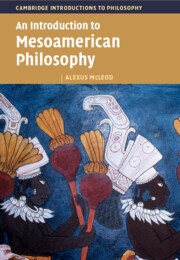Refine search
Actions for selected content:
68 results
NGOization, Foreign Funding, and the Nicaraguan Civil Society
-
- Journal:
- Voluntas: International Journal of Voluntary and Nonprofit Organizations / Volume 25 / Issue 2 / April 2014
- Published online by Cambridge University Press:
- 01 January 2026, pp. 487-513
-
- Article
- Export citation
Molineid nematodes of amphibians and reptiles: A checklist of Caribbean, Panamanian, and Neotropical species and notes on their biology and host associations
-
- Journal:
- Parasitology , First View
- Published online by Cambridge University Press:
- 12 December 2025, pp. 1-17
-
- Article
-
- You have access
- Open access
- HTML
- Export citation
Chapter 6 - Applying the Atlantic Charter to the Caribbean Basin
-
-
- Book:
- Antifascism(s) in Latin America and the Caribbean
- Published online:
- 21 July 2025
- Print publication:
- 07 August 2025, pp 126-142
-
- Chapter
- Export citation
A Preceramic–Preclassic transition cemetery at the Lowland Maya site of Ceibal, Guatemala
-
- Article
-
- You have access
- Open access
- HTML
- Export citation
Of puppets and puppeteers: Preclassic clay figurines from San Isidro, El Salvador
-
- Article
-
- You have access
- Open access
- HTML
- Export citation
9 - War and the State in Mexico and Central America
- from Part III - Case Studies
-
- Book:
- Bringing War Back In
- Published online:
- 14 November 2024
- Print publication:
- 21 November 2024, pp 223-262
-
- Chapter
- Export citation
8 - The Protein Factor
- from Part II - Science as Development
-
-
- Book:
- Agricultural Science as International Development
- Published online:
- 14 November 2024
- Print publication:
- 21 November 2024, pp 181-206
-
- Chapter
-
- You have access
- Open access
- HTML
- Export citation
Genomic characterization of a new species of Pseudoparacreptotrema (Digenea: Allocreadiidae) from Puerto Rico, with comments on the biogeography of the genus
-
- Journal:
- Journal of Helminthology / Volume 98 / 2024
- Published online by Cambridge University Press:
- 18 November 2024, e72
-
- Article
- Export citation
Emergency Responses to COVID-19 and Opportunities for Inclusive Social Policy
-
- Journal:
- Journal of Social Policy , First View
- Published online by Cambridge University Press:
- 07 November 2024, pp. 1-17
-
- Article
-
- You have access
- Open access
- HTML
- Export citation
Earliest Ancient Maya salt production in southern Belize: excavations at Jay-yi Nah
-
- Article
-
- You have access
- Open access
- HTML
- Export citation
Running out of empty space: environmental lidar and the crowded ancient landscape of Campeche, Mexico
-
- Article
-
- You have access
- Open access
- HTML
- Export citation
Borders, Migration and Asilo Sagrado: How Early Central American Nations Used Open Borders to Reinforce Sovereignty
-
- Journal:
- Journal of Latin American Studies / Volume 56 / Issue 3 / August 2024
- Published online by Cambridge University Press:
- 10 October 2024, pp. 415-438
- Print publication:
- August 2024
-
- Article
-
- You have access
- Open access
- HTML
- Export citation
Sightings of Bryde's whale, Balaenoptera edeni, off the Pacific coast of Nicaragua
-
- Journal:
- Journal of the Marine Biological Association of the United Kingdom / Volume 104 / 2024
- Published online by Cambridge University Press:
- 05 April 2024, e40
-
- Article
-
- You have access
- Open access
- HTML
- Export citation
Disasters in the Northern Triangle: A Descriptive Analysis Using the EM-DAT Database 1902-2022
-
- Journal:
- Prehospital and Disaster Medicine / Volume 38 / Issue 5 / October 2023
- Published online by Cambridge University Press:
- 27 September 2023, pp. 668-676
- Print publication:
- October 2023
-
- Article
- Export citation
The Pharmaceutical Market for Biological Products in Latin America: A Comprehensive Analysis of Regional Sales Data
-
- Journal:
- Journal of Law, Medicine & Ethics / Volume 51 / Issue S1 / Fall 2023
- Published online by Cambridge University Press:
- 29 December 2023, pp. 39-61
- Print publication:
- Fall 2023
-
- Article
-
- You have access
- Open access
- HTML
- Export citation

An Introduction to Mesoamerican Philosophy
-
- Published online:
- 28 July 2023
- Print publication:
- 03 August 2023
7 - Atlantic Crossing: On to the Americas, 1600–1800
-
- Book:
- The Long Journey of English
- Published online:
- 25 May 2023
- Print publication:
- 08 June 2023, pp 76-98
-
- Chapter
- Export citation
11 - Conclusion
- from Part III - Institutional Persistence
-
- Book:
- Undermining the State from Within
- Published online:
- 23 February 2023
- Print publication:
- 02 March 2023, pp 240-262
-
- Chapter
- Export citation
3 - Civil War in Central America
- from Part II - Institutional Origins
-
- Book:
- Undermining the State from Within
- Published online:
- 23 February 2023
- Print publication:
- 02 March 2023, pp 63-88
-
- Chapter
- Export citation
10 - Transnational Visions of Black Women Writing
- from Part III - Global Connections
-
-
- Book:
- African American Literature in Transition, 1980–1990
- Published online:
- 02 February 2023
- Print publication:
- 09 February 2023, pp 212-234
-
- Chapter
- Export citation
